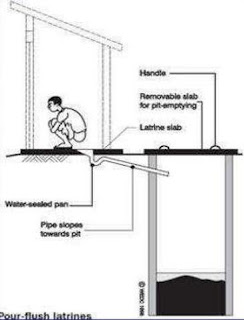Chapter 5
Living the Life
There
were still a lot to do. We helped in making the first water-sealed toilet in
the village. As the water source, lines of bamboo were connected together and
placed at the water source higher in location and let in drain to collecting
drums downstream. Whatever excesses the water spills over to a rivulet
downstream and joins the bigger Saltan river.
 |
| Taken from http://toiletcrisis.weebly.com/water-sealed-latrine.html |
We
started to see patients in the clinic and started planning our community
diagnosis. We met the village leaders, community workers, teachers and
volunteers and told them that the survey is to determine their health needs and
not for any other things. We planned with the community and set our deadlines.
In a week’s time, we had our survey and then we came out of a community
diagnosis.
Community Diagnosis (community
We
prepared a customized curriculum for the volunteers. Each Sitio of Gawaan had
their own representatives. We had also a representative from Mabaca. The
training was a once a week lecture that would culminate on October. The
volunteers were assigned to assist us in our clinics too.
 |
| Photo taken from https://www.doh.wa.gov/portals/1/images/8349/CHWT5.png |
While
we worked in the community, we were assimilated into their lives. We ate their
food and lived their daily lives. We learned to eat sardines laced with a
handful of siling labuyo. We learned to eat the eel (iwat or igat) which was
caught at the Saltan river. And we loved most their own version of tinola made
of native chicken. We learned to bathe in a tributary of the Saltan river and
it was where we also was our clothes. We have learned the fear the great Saltan
River. In one picnic along its bank, Chita attempted to swim across but she was
carried downstream because of the rapid waters of the river. It was good
Chita was assisted downstream by a strong and mighty Gawaan lad.
 |
| A collage of Kalinga food |
When
it was harvest time for coffee. We joined our family in going to their coffee
farm. We were amazed how vast the coffee plantations were. For the people of
Gawaan, coffee is a culture. They took extra care in planting their coffee
seedlings. They have found out that the best species of coffee to be planted is
the arabica species. They have a technique in planting. We noticed that they do
not wait for all the coffee seeds to ripen. They harvest the mature green
fruits. The coffee fruits were dried under the sun and were then placed on a
crackle. When seeds come out, they are ready to be roasted. When roasted they
are keep in a container cans to preserve the aroma. When they brew the coffee,
the roasted seeds are pounded and eventually brewed. The Gawaan brew is
reminiscent of the brewed coffee I tasted in Bologna, Italy. All of these
processes were filled with diligence, dedication and laborious toil of the
Gawaan worker.
 |
| Photo taken from gmanetwork.com |
Coffee
is a cash crop. Once it had undergone the laborious process, the seeds are sold
in Salegseg where a trader eventually takes it and sell in the capital city. In
the present, there is now an increasing interest in the Kalinga coffee.
Filipinos love coffee and I am sure that they would love the aroma and taste of
the Kalinga coffee. I hope in the near future, a cafe like Figaro that utilizes
Cavite coffee beans will be made and this time will only utilize the Kalinga
coffee beans.
Note:
If the pictures are not attributed to a website or a person, it is mine. Those who own the pictures I have used and does not want to appear in this blog, please e-mail me at rqmallari60@gmail.com and I would be more than willing to remove them. Thank you.








Walang komento:
Mag-post ng isang Komento